The Art of Kayabi Tattoo
Of course, every literary account I read describing Kayabi tattooing practices (English, Portuguese, and Spanish) stated that genipapo was the source of their tattooing pigment, as it was amongst the Kayabi’s enemies. Certainly, I was astonished when I discovered that the Kayabi’s tattoo pigment actually came from resin extracted from the bark of another species of tree!
Now, I can totally understand the confusion that early explorers and ethnographers faced when they attempted to describe tattooing practices in the Xingu River basin; semi-permanent genipapo is virtually indistinguishable from the tattoo resin of the ipau-ip tree. In fact, during my recent visit to the Xingu reserve, I learned that only one elderly man named Tiwit – who was born and tattooed in the traditional Kayabi homeland of the Rio dos Peixes region – could identify the ipau-ip tree when his people migrated to the Xingu in the early 1960s. The reason for this is that the tree is extremely rare in the Xingu, and by the time of the Kayabi migrations, most men and women had not received tattoos in nearly twenty years.
However, approximately ten years after the Kayabi arrived in the Xingu, interest in tattooing appeared again and this resurgence was due in large part to the efforts of one Kayabi man named Xyxt who was to become the last great Kayabi tattoo master. |
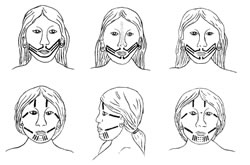 |
Early 20th century drawings of Kayabi women depicting various styles of facial tattooing. |
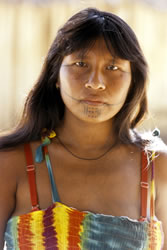 |
A younger Kayabi woman carries on the indelible tradition. Photograph © Lars Krutak 2007-2010 |
The Last Kayabi Tattoo Master
According to Jemy Kaiabi, who is Xyxt’s nephew, the tattoo master was deeply fascinated by the tattooing traditions of his people at an early age. His father was a great warrior and he learned many of the traditional tattooing designs from him. Combining this knowledge with interviews of Kayabi elders who lived in several villages, Xyxt compiled a vast “directory” of names and designs which he kept locked away in his memory. As Jemy told me, “he saw that our customs were disappearing before us when most Kayabi didn’t seem to care. He was a visionary, and a role model. He then began to give traditional facial tattoos to some of the girls and boys in the Xingu. And about seven years ago, he tattooed Kurapi and some of the girls here in Capivara village – these were his last works of art. No one had been tattooed in the Kayabi style since the early 1950s, and this was a great achievement!”
|
|
But all of a sudden this tattoo renaissance came crashing to a standstill with the death of the master in 2003. “Xyxt was not an old person, he was forty years old, a young man when he was murdered,” Jemy said. “When he went back to our homeland in the Rio dos Peixes to urge our people to return to our traditional practices and to fight the rubber tappers and farmers who were taking our ancestral lands, he disappeared after visiting a blanco bar one night. The white people killed him, and his body was never found. He didn’t have enough time to pass on to his apprentices all of his secrets, so a lot of information was buried with him. For example, we don’t use the traditional name glyphs anymore because the tattoo masters who know them are all dead. And with more contact with the Portuguese language, we have begun to tattoo our names in letters.” |
“Of course, most of the young people here in the village are not concerned about the loss of the tattoo master. But I am, because we need to replace him; otherwise our tattooing tradition will probably die. That is why I started cataloging the history of our tattooing practices and each of the tattoos’ meanings after the Master died. I also learned how to prepare the ink from the Master’s description on a piece of paper, and from the help of Tiwit. From a practical standpoint, no one showed me how to do it. I had to practice to get it right.”
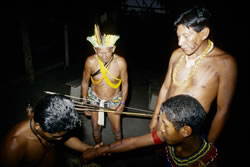 |
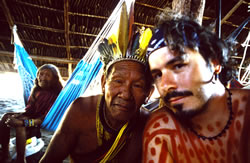 |
Kurapi tattooing a new initiate under the watchful eyes of Tiwit and the shaman Tuiarajup. Because the Kayabi and a handful of other Amazonian groups continue to practice tattooing, this means that South America has the longest living history of indigenous tattooing practices in the world dating back some 7000 years. Previously, Japan had the oldest continuous history of tattoo culture, but in 1998 the last indigenous Ainu women died and so too did a tattooing tradition that some scholars believed was 10,000 years old! Photograph © Lars Krutak 2007-2010 |
The author posing with Tiwit and his wife who were my house-hosts in Capivara village. The cutia-teeth ear spools I am wearing are not only worn as adornment by the Kayabi, but they are also supposed to make you “hear better” after you have been initiated. Photograph © Lars Krutak 2007-2010 |
Jemy continued, “I am one of four school teachers in my village, and I want everyone to have a general knowledge of the history of my people, including tattoo history. Everyone in the world knows the Kayabi tattooed. If we stopped and someone came up to me and said ‘you are not tattooed, so how can you be Kayabi?’ Then, I would have to say that we lost one of the most important aspects of our culture and identity. But we cannot afford to let that happen. So I keep working to learn as much as I can, including how to tattoo.”
The Future of Kayabi Tattoo
If Jemy or his tattooing cousin Kurapi have anything to say about it, the future of Kayabi tattooing is no longer in doubt. Jemy told me, “I believe there is something about tattooing that lives deep inside our historical consciousness as a people. It is an important cultural element because it forms part of the roots of our people, so it must be continued.”
 |
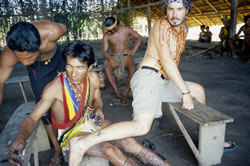 |
As Jemy prepared to tattoo me, he said: “We have never tattooed an enemy before, and we consider all white people to be our enemies. They have taken our lands, raped our women, and abducted our children. But I know you wouldn’t do those things, and since you have lived with us and learned our customs, then I can tattoo you.” Photographs © Lars Krutak 2007-2010 |
“For example, when a young person completed their initiation in the past, they always received a name and with it a new soul. This soul became permanently attached to the individual when he or she was tattooed with their new name glyph. Today, I believe that not all of the young people receive their soul because they are not tattooed. Therefore, I am worried that their souls will become confused, and if they are left untreated this soul-loss can cause death, sickness, or even trouble for the community. So if we don’t tattoo anymore, we will be out of our tradition and that is unacceptable. That is why I am conducting a deep study to gather the glyph meanings from existing elders and to start tattooing them again.”
“Of course, we will be ‘true’ Kayabis again once we get our tattoo masters. And I know that me and Kurapi will become masters. Even though I haven’t yet mastered all of the knowledge it takes to become one, I am getting close. So I think that everything will take care of itself as long as we continue to practice and learn everything we can from our elders and put that knowledge to good use.”
Next Page | 1
|
2 |
3 |
4 |
5 |
6 |
7 |
8 |
Museum photo gallery of the images
on this page may be seen here. |






